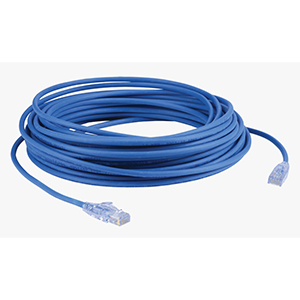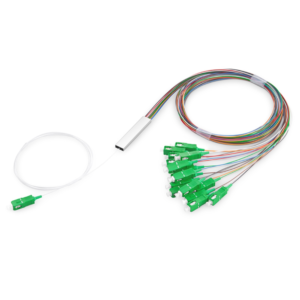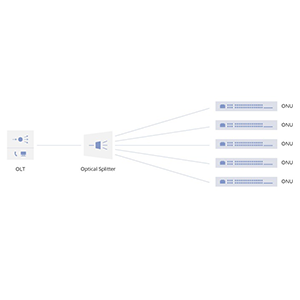Switch ports undoubtedly play an important role in the network. This article will focus on the characteristics of switch SFP ports. We will first define the physical characteristics of SFP (Small Form-factor Pluggable) ports and explain their functions and applications in switches. Next, we will analyze the advantages of SFP ports over traditional Ethernet ports and explain their advantages in high-speed transmission, modularity, etc.
We will introduce common SFP module types, such as Gigabit SFP, 10GbE SFP+, etc., and describe the applications of different SFP modules in different network scenarios. In addition, we will explain the configuration and management methods of switch SFP ports and analyze their roles in switch networks. Finally, we will explore the compatibility requirements of SFP modules and switch ports and introduce how to ensure the interoperability of SFP ports and fiber optic cables.
Basic concepts of SFP ports
Let me introduce the basic concepts of SFP ports in detail.
Physical characteristics of SFP port:
(1) Definition:
- SFP (Small Form-factor Pluggable) is a small pluggable optical/electrical interface standard.
- Compared with the previous large fiber optic transceiver, SFP is smaller and easier to install.
(2) Physical dimensions:
- The SFP port has a small size, about 5.7cm in length, about 1.2cm in width, and about 0.6cm in thickness.
- This miniaturized design enables it to be more compactly integrated into devices such as switches.
(3) Interface type:
- SFP port supports both fiber optic interface and copper cable interface.
- Fiber SFP is used to connect to fiber networks, and copper SFP is used to connect to cable networks.
(4) Transmission rate:
- SFP ports can support different rates such as 1Gbps, 2.5Gbps, 4Gbps, 8Gbps, and 10Gbps.
- The transmission rate depends on the specific model and technical parameters of the SFP module.
Functions and applications of SFP ports in switches:
(1) Network interface:
- SFP ports are used as network interfaces of switches to connect to other devices (such as routers and servers).
- SFP modules are used to achieve optical/electrical conversion and support different types of network connections.
(2) Modular design:
- The SFP port adopts a modular design, and the SFP module can be flexibly replaced according to needs.
- Different types of SFP modules can provide different transmission rates and media types.
(3) Convenient management:
- The SFP port is compact in design, which is conducive to the wiring management and maintenance of the switch.
- The SFP module can be quickly plugged in and out, which is convenient for network configuration and adjustment.
(4) Cost-effectiveness:
- Compared with the previous large fiber optic interface, the SFP port is lower in cost and easier to deploy.
- SFP modules can be flexibly selected according to actual needs to improve the investment benefits of the network.
In short, as the interface of the switch, the SFP port has the advantages of miniaturization, modularization, and convenient management. It is widely used in enterprise and operator networks and is one of the important technologies to support high-speed network construction.
Main features of SFP ports
Let me analyze in detail the main features and advantages of SFP ports compared with traditional Ethernet ports.
Advantages of SFP ports compared with traditional Ethernet ports:
(1) Miniaturization design:
- The physical size of the SFP port is smaller, which greatly reduces the space occupied by the device.
- This is conducive to improving the integration and deployment flexibility of the device.
(2) Modular features:
- The SFP port adopts a modular design, and the SFP module can be flexibly replaced according to needs.
- Different SFP modules can support different transmission media and rates, improving the scalability of the system.
(3) Support high-speed transmission:
- SFP ports can support 1G, 2.5G, 4G, 8G, 10G and other high-speed Ethernet transmission.
- Compared with traditional Ethernet ports, it has higher bandwidth and transmission performance.
(4) Power efficiency:
- SFP has a more streamlined design and lower power consumption, which helps to reduce the total power consumption of the device.
- This feature is particularly important for fanless compact devices.
(5) Cost-effectiveness:
- The manufacturing cost of SFP ports is lower, which helps to reduce the overall cost of the device.
- With flexible modular features, deployment can be customized according to actual needs.
Advantages of SFP ports in high-speed transmission and modularity:
(1) High-speed transmission capability:
- SFP ports support a variety of high-speed Ethernet standards such as 1G, 2.5G, 4G, 8G, and 10G.
- It can meet the network transmission rate requirements of future high-bandwidth applications.
(2) Flexible modular design:
- SFP ports adopt modular plug-in design, and SFP modules can be flexibly replaced according to needs.
- Different SFP modules can provide multiple interface options such as optical fiber, copper cable, and different wavelengths.
(3) Convenient network deployment:
- SFP modules can be quickly plugged in and out, making network configuration and maintenance easier.
- It is conducive to improving the flexibility and scalability of the network.
(4) Cost saving:
- Based on the modular design of the SFP port, the deployment can be customized according to actual needs.
- Reduces over-investment or resource waste and improves the investment efficiency of the equipment.
In short, the SFP port has obvious advantages over the traditional Ethernet port due to its miniaturization, high-speed transmission, and modularization. These advantages have made it widely used in high-speed network equipment and is one of the important technical supports for future network development.
Types and applications of SFP modules
Let me introduce you to the common types of SFP modules and their applications in different network scenarios.
Common SFP module types:
(1) Gigabit SFP module:
- Supports 1000Mbps Ethernet transmission rate.
- Can support optical fiber or copper cable media connection.
(2) 10GbE SFP+ module:
- Supports 10Gbps Ethernet transmission rate.
- Uses a more compact SFP+ physical interface specification.
(3) 40GbE QSFP+ module:
- Supports 40Gbps Ethernet transmission rate.
- Uses a 4-channel parallel QSFP+ interface specification.
(4) 100GbE QSFP28 module:
- Supports 100Gbps Ethernet transmission rate.
- Uses the more compact QSFP28 physical interface specification.
Application of different SFP modules in network scenarios:
(1) Gigabit SFP module:
- Applied to medium-speed networks such as small and medium-sized enterprise networks and campus networks.
- Can provide 1Gbps high-speed connection to meet the needs of general users.
(2) 10GbE SFP+ module:
- Applied to high-speed network scenarios such as data centers and backbone networks.
- Provides 10Gbps ultra-high-speed connection to support massive data transmission.
(3) 40GbE QSFP+ module:
- Applied to ultra-high-speed network scenarios such as large data centers and cloud computing networks.
- Can provide 40Gbps bandwidth to meet the needs of next-generation applications.
(4) 100GbE QSFP28 module:
- Applied to the latest ultra-large capacity data center networks.
- Provides 100Gbps ultra-high-speed transmission capability to support massive business carrying.
In short, SFP modules with different speeds are suitable for network scenarios at different levels. With the continuous evolution of application requirements, the speed of SFP modules is also constantly improving, providing strong support for high-speed networks. Network managers need to select appropriate SFP modules according to actual needs to build a high-performance and highly scalable network system.
Deployment of SFP ports in switches
Let me introduce the deployment and management methods of SFP ports in switches, as well as the role they play in switch networks.
Configuration and management of switch SFP ports:
(1) Port configuration:
- The SFP ports on the switch need to be configured according to the type of SFP modules connected.
- Including configuring parameters such as transmission rate, media type, and duplex mode.
(2) Port monitoring:
- The switch can monitor the status of the SFP port, such as link status, optical power, etc.
- Network faults can be discovered and diagnosed in a timely manner through monitoring.
(3) Port management:
- The switch supports hot-swapping, port disabling/enabling and other management operations on SFP ports.
- The use of SFP ports can be flexibly adjusted according to needs.
(4) Port diagnosis:
- The switch can perform diagnostic tests on SFP ports to detect link quality.
- It is helpful to quickly locate and solve network problems related to SFP ports.
The role of SFP ports in switch networks:
(1) Network access:
- The SFP port serves as the network interface of the switch to achieve connection with other devices.
- Supports network interconnection at all levels from end users to backbone networks.
(2) High-speed transmission:
- SFP ports support ultra-high-speed Ethernet transmission up to 100Gbps.
- It can meet the bandwidth requirements of future massive data transmission services.
(3) Flexible expansion:
- SFP ports adopt modular design, and SFP modules can be flexibly selected and replaced according to needs.
- It helps to flexibly upgrade and expand the switch network.
(4) Equipment integration:
- The miniaturized design of SFP ports is conducive to the integration and deployment of switches and other equipment.
- It improves the density and space utilization of equipment.
In short, as an important network interface of the switch, the SFP port undertakes key functions such as network access, high-speed transmission, and flexible expansion. Through the reasonable configuration and management of the SFP port, the high performance and high reliability of the switch network can be ensured to meet the needs of future business development.
Summary
Reasonable configuration of the switch SFP port is crucial to building a high-performance network. Our company has long been focusing on the research and development and production of network equipment and its supporting products, and has rich industry experience. Our SFP series products have reached the industry-leading level in optical performance and reliability, and can meet your demanding needs for high-speed network construction.
Whether you need to deploy in a data center, enterprise office, or operator network environment, we can provide you with customized SFP solutions. At the same time, our professional team will provide you with a full range of technical support, including on-site surveys, product recommendations, configuration guidance, and interoperability verification. Contact us now to learn more about the switch SFP port.
SFP Port FAQ
An SFP (Small Form-Factor Pluggable) port is a compact, hot-swappable interface found on network equipment, such as switches, routers, and media converters, that allows the connection of different types of SFP transceivers.
The primary purpose of an SFP port on a switch is to provide a flexible and scalable way to connect high-speed network interfaces, such as Gigabit Ethernet or Fibre Channel, using various fiber optic or copper cable options.
SFP ports can accommodate a wide range of SFP transceivers, including copper (RJ-45) and fiber optic (LC, SC) models, supporting different Ethernet and communications standards.
SFP ports offer more flexibility and scalability compared to fixed network ports, as they allow the network administrator to choose the appropriate transceiver based on the specific requirements of the deployment.
SFP ports on switches typically support Gigabit Ethernet (1 Gbps), 10 Gigabit Ethernet (10 Gbps), and even higher-speed Ethernet protocols, as well as Fibre Channel and SONET/SDH interfaces.
Installing an SFP transceiver generally involves simply inserting the transceiver into the SFP port and ensuring it clicks into place. Configuration may be required within the switch’s software or management interface.
Key advantages include the ability to support a wide range of network media, the flexibility to upgrade or replace transceivers as needed, and the compact form factor that allows for higher port densities.
Potential issues may include ensuring compatibility between the switch and the SFP transceiver, managing power and thermal dissipation, and the potential for insertion/removal damage to the SFP ports.
Troubleshooting may involve checking the transceiver type, cable connections, power, and configuration settings, as well as verifying the overall network connectivity.
Ongoing advancements include the introduction of higher-speed SFP+ and QSFP ports, as well as the integration of additional features like network monitoring and diagnostics.




